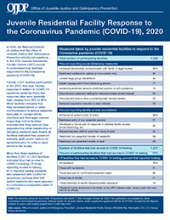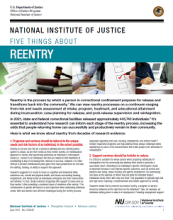Showing Results For:
Subtopic: Corrections
Juvenile Residential Facility Response to the Coronavirus Pandemic (COVID-19), 2020
Date Published
May 2023
Agencies
NIJ-Sponsored,
OJJDP-Sponsored
Five Things About Reentry
Date Published
April 2023
Agencies
NIJ
The Overlooked Role of Jails in the Discussion of Legitimacy: Implications for Trust and Procedural Justice
Date Published
April 2023
Journal
Corrections Today
Agencies
NIJ
Solidarity or Solitude? Correlates of Incarceration and the Peer Networks of Imprisoned Women
Date Published
March 2023
Journal
Justice Quarterly
Agencies
NIJ-Sponsored
Solitary Confinement and Prison Personnel: Emotional Numbing as a Response to Work in Extended Restrictive Housing
Date Published
March 2023
Journal
Incarceration
Agencies
NIJ-Sponsored
The Only Thing Constant is Change: Temporal Analyses of Racial/Ethnic Sentencing Disparities
Date Published
March 2023
Journal
American Journal of Criminal Justice
Agencies
NIJ-Sponsored
Emerging Relevance of Neuroscience in Corrections
Date Published
March 2023
Journal
Corrections Today
Agencies
NIJ-Sponsored
Leveraging Technology to Support Prisoner Reentry
Date Published
March 2023
Agencies
NIJ-Sponsored
Comparing the Uses and Benefits of Stationary Cameras Versus Body-worn Cameras in a Local Jail Setting
Date Published
2023
Agencies
NIJ-Sponsored
Barriers and Opportunities for Suicide Prevention Among Correctional Officers: An Issue Brief for Clinicians
Date Published
2023
Agencies
NIJ-Sponsored
Restrictive housing for prison rule violators: Specific deterrence or defiance?
Date Published
2023
Journal
Journal of Experimental Criminology
Agencies
NIJ-Sponsored
De-escalation Training: What Works, Implementation Lessons, and Taking It to Scale; Plenary at the 2023 NIJ Research Conference
Date Published
2023
Agencies
NIJ
Supporting Women’s Reentry from Incarceration: Discussing Promising Practices & Future Research
Date Published
2023
Agencies
NIJ
The Implications of Stress Among Correctional Officers: A Summary of the Risks and Promising Intervention Strategies
Date Published
2023
Journal
International Journal of Offender Therapy and Comparative Criminology
Agencies
NIJ-Sponsored
Mismatches and criminal justice policy: The case of GPS for domestic violence
Date Published
2023
Journal
Criminology & Criminal Justice
Agencies
NIJ-Sponsored
A Mixed Method Evaluation of the Role of Religion in Desistance and Reentry
Date Published
2023
Journal
Justice Quarterly
Agencies
NIJ-Sponsored
A Within-Person Test of the Impact of Extended Solitary Confinement on Mental Health Functioning and Service Use
Date Published
2023
Journal
Criminal Justice and Behavior
Agencies
NIJ-Sponsored
Circumventing the Sentencing Grid: Encouraging Downward Departures in Presumptive Prison Cases
Date Published
2023
Journal
Criminal Justice Policy Review
Agencies
NIJ-Sponsored
Captives of the "Society of Captives": Working in Solitary Confinement
Date Published
2023
Journal
Prison Journal
Agencies
NIJ-Sponsored
Body-Worn Cameras in a Correctional Setting: Assessing Jail Deputy Attitudes Before, During, and After Implementation
Date Published
2023
Journal
Justice Evaluation Journal
Agencies
NIJ-Sponsored
Traumatic brain injury and mental health outcomes among recently incarcerated men
Date Published
2023
Journal
Journal of Traumatic Stress
Agencies
NIJ-Sponsored
Social Support, Victimization, and Stress in a Women’s Prison: The Role of in-Prison Friendship for Reducing Perceptions of Stress
Date Published
2023
Journal
Women & Criminal Justice
Agencies
NIJ-Sponsored
Revalidation of the First Step Act Risk Assessment: A Test of Predictive Strength, Dynamic Validity, and Racial/Ethnic Neutrality
Date Published
2023
Journal
Crime & Delinquency
Agencies
NIJ-Sponsored
Racial Politics in the Contemporary Prison Society: The Importance of Race and Ethnicity to Prison Social Organization
Date Published
2023
Journal
Criminal Justice and Behavior
Agencies
NIJ-Sponsored
Research Forensic Library
We invite you to also search the Research Forensic Library, a curated collection of publicly-accessible material relating to every discipline of the forensic sciences.




